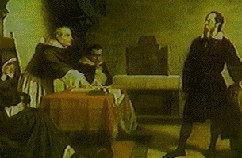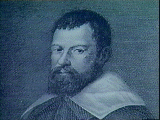 |
Galileo Galilei was an Italian astronomer and physicist who lived from 1564 to 1642. He was the first to use a telescope to observe the stars and planets.
Earlier in the century, another astronomer named Nicolaus Copernicus had theorized that the Earth and other planets travelled around the sun. This was an important theory because it suggested that the earth was not the center of the universe, as previous generations had assumed.
 |
As a result of his own study, Galileo decided to support Copernicus' view of the solar system. At that time, the Catholic Church was as powerful as the most stringent dictatorship today. Everything that was done or said or thought had to be pre-approved by the Church. The Pope allowed Galileo to write a book on his views. Then one of Galileo's enemies caused Galileo to go before an Inquisition, saying that his discoveries went against the Church's teachings. He spent the rest of his life under house arrest but managed to write another book, which was secretly published in Holland. The Catholic Church would have had him burned if they had found out about this book.
 |
Today we remember that Galileo invented an astronomical telescope. He tried to prove the things he saw to other people. The Church did not want people to believe him.
Page created on 8/26/2009 9:39:08 AM
Last edited 8/26/2009 9:39:08 AM
During the flybys of Venus and the Earth, Galileo's scientists took the opportunity to study these two planets as well as the Moon, making some unprecedented observations. In addition, following each Earth flyby, Galileo made excursions as far out in the solar system as the asteroid belt, enabling scientists to make the first close-up studies of two asteroids, Gaspra and Ida. The Galileo mission scientists were fortunate to be the only ones with a direct view of the Comet Shoemaker-Levy 9 fragment impacting on Jupiter.
